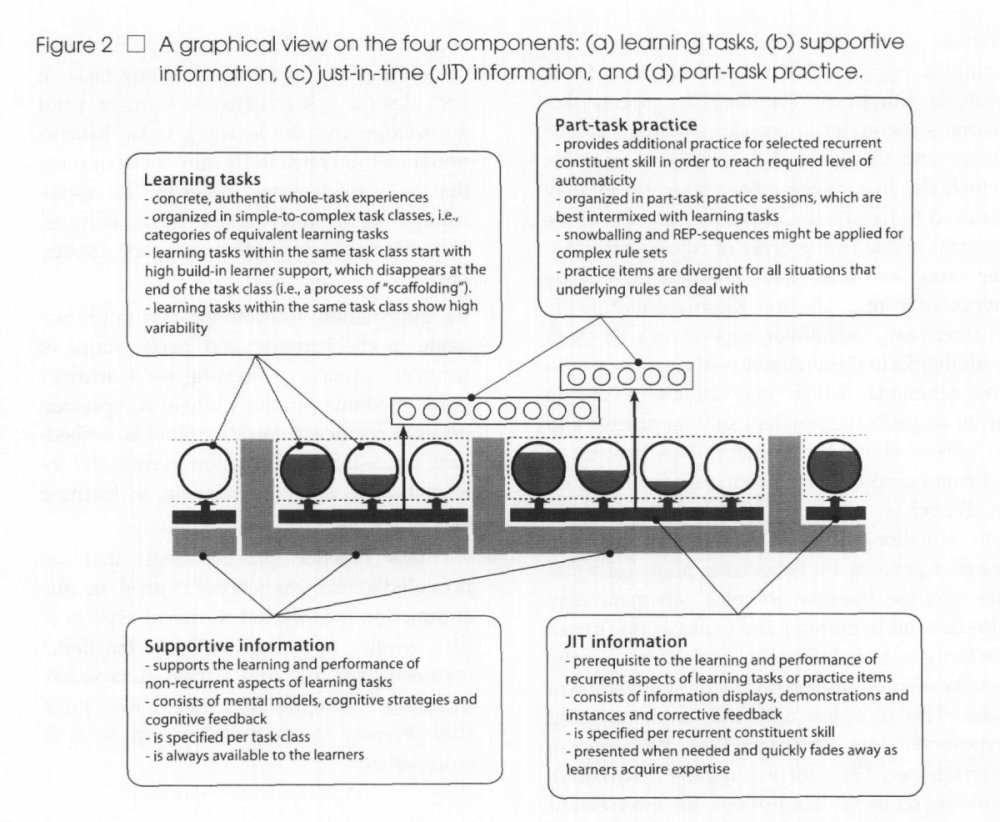4C-ID
Definition
- 4C/ID is an instructional design model by van Merriënboer and others.
- "4C" means "four components", "ID" means "Instructional Design". It also can be found in Merrill's first principles of instruction.
- According to Martin Ryder, the The 4C-ID instructional model is characterized by four components: (1) Learning Tasks, (2) Supportive Information, (3) Procedural Information and (4) Part-Task Practice. The tasks are ordered by task difficulty and each task offers at the beginning a lot of scaffolding which is reduced as the learner progresses.
See also: Elaboration theory (a much earlier model from Reigeluth).
The design
4C/ID is what I call a "main-stream" Instructional Design Model that addresses the issue of how to teach complex skills, i.e. solid know-how that can be applied to real problem problems.
According to Merriënboer et al. (2002): “The 4C/ID-model [....] addresses at least three deficits in previous instructional design models. First, the 4C/ID-model focuses on the integration and coordinated performance of task-specific constituent skills rather than on knowledge types, context or presentation-delivery media. Second, the model makes a critical distinction between supportive information and required just-in-time (JIT) information (the latter specifies the performance required, not only the type of knowledge required). And third, traditional models use either part-task or whole-task practice; the 4C/IDmodel recommends a mixture where part-task practice supports very complex, "whole-task" learning.”
According to Merrill (2002:56), the model is clearly problem-based although not in the sense of typical problem-based learning models. “At the heart of this training strategy is whole-task practice, in which more and more complex versions of the whole complex cognitive skill are practiced. In ... the analysis phase ... the skill is decomposed in a hierarchy of constituent skills; ... classified as recurrent constituent skills, which require more-or-less consistent performance over problem situations, or nonrecurrent constituent skills, which require highly variable performance over situations" (p. 8). "While learners practice simple to complex versions of a whole task, instructional methods that promote just-intime information presentation are used to support the recurrent aspects of the whole task while, at the same time, instructional methods that promote elaboration are used to support the non-recurrent aspects of the task" (p. 10).”
The four components are described in detail in Merrienboer (2002) and from which this picture is taken:

Some features of 4C/ID
4C/ID can be described as a method that will describe the backbone of a curriculum where each element is connected and does have a function with respect to the whole.
Learning tasks
Create a spiral sequence of tasks, based on induction
- Provide variability in each task
- Provide task classes: sequences from easy to difficult, but they should be meaningful right from the start and make sure to offer several variants for each class
- Provide guidance: Scaffolding should be provided in each task taking into account ZPD using a swatooth pattern (first task in a class uses a lot of support, last task in a class should have no support (and if learners are successful, then move them to a higher level)
Supportive information
Is information that helps doing the tasks, shows how the domain is organized (e.g. anatomy in medecine), shows how to approach a task, based on knowledge elaboration. Is linked to all tasks in a given class. An other class may require more simple or more difficult information
- Can be provided before (tell "theory") or during a task sequence (typically in project-oriented designs)
- "What should I study in order to be able to....." (self-directed learners)
Procedural information
Based on knowledge compilation
- Routine aspects
- How-to information that is used "just-in-time"
Part-task practice
Based on strengthening
- Repetition and drill
- However, part-time practice should only be presented within a cognitive context, i.e. a whole task
- Sometimes more practice is needed for procedure learning
References
- Merrill, David, First Principles of Instruction, ETR&D, Vol. 50, No. 3, 2002, pp. 43-59 ISSN 1042-1629. Preprint version
- van Merriënboer, J.J.G (1997). Training complex cognitive skills: A four-component instructional design model for technical training. Englewood Cliffs, NJ: Educational Technology Publications
- van Merriënboer, Jeroen.J.G, Richard E Clark, Marcel B M de Croock, (2002) Blueprints for complex learning: The 4C/ID-model, Educational Technology, Research and Development. 50 (2);39-64, DOI: 0.1007/BF02504993, Abstract/PDF (Access restricted).
- Frederick Kwaku Sarfo & Jan Elen, Powerful Learning Environments and the Development of Technical Expertise in Ghana: Investigating the Moderating Effect of Instructional Conceptions, IEEE Explore, ??? PDF
- van Merriënboer, J.J.G & Kirshner, P. (2007). Ten Steps to Complex Learning. Erlbaum.